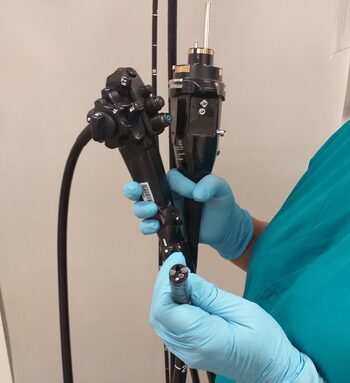- IT
- |
- EN

[Date of last update: february 2021]
Infectious risk can be controlled through an adequate reprocessing process [1].
Infections can be endogenous or exogenous in nature. A recent review by Kavoleva et al. [2], indicates that most of the time the origin of the infection is of endogenous nature.
The most frequently isolated microbial species are Escherichia coli, Klebsiella spp., Enterobacter spp. and enterococci. The microorganisms of exogenous origin most frequently associated with infections are:
- Pseudomonas aeruginosa and Salmonella spp. during gastrointestinal endoscopy
- Pseudomonas aeruginosa or mycobacteria during bronchoscopy.
Contamination of the endoscope during endoscopic procedures, endoscope washers or from contaminated treatment water promotes their spread.
This type of infection can be prevented through rigorous reprocessing and storage procedures. The safety margin [3] to ensure an effective reprocessing process is minimal, contamination of the internal canal of gastrointestinal endoscopes, including duodenoscopes, can contain up to 7-10 Logs of enteric organisms. The endoscope cleaning process can reduce the number of microorganisms by 4 logs and the disinfection by another 4-5 logs.
The incidence of infections [4] is about 1 infection per 1,8 million procedures.
A CRE infection / colonization cluster [5] has been correlated with the use of duodenoscopes in ERCP.
A review showed that in the past ERCP were associated with only 23 clusters (1975-2010) mainly supported by Pseudomonas aeruginosa and rarely by enterobacteria. In September 2013, an outbreak occurred in the Chicago hospital, 10 patients were infected and 28 colonized with carbapenemase-producing Klebsiella pneumoniae after an endoscopic procedure. The cause was related to the characteristics of the duodenoscope which did not allow the effective cleaning and disinfection.
Reprocessing Microbiological surveillance is a modality used to identify any systemic error in the procedures adopted, and to detect the presence of micro-lesions that facilitate the biofilms development.
[1] CDC HIPAC, (2018). Essential Elements of a Reprocessing Program for Flexible Endoscopes – Recommendations of the HICPAC. Disponibile in https://www.cdc.gov/hicpac/recommendations/flexible-endoscope-reprocessing.html
[2] Kavoleva, J., Peters, F. T. M., Van der Mei, H. C., Degenera, J. E. (2013, Apr). Transmission of Infection by Flexible Gastrointestinal Endoscopy and Bronchoscopy, Clinical Microbiology Reviews; 26(2): 231–254. doi: 10.1128/CMR.00085-12 Disponibile in: https://www.ncbi.nlm.nih.gov/pmc/articles/PMC3623380/
[3] Rutala, W. A., Weber, D.J. (2016, May 2). Outbreaks of carbapenem-resistant Enterobacteriaceae infections associated with duodenoscopes: What can we do to prevent infections? American Journal of Infection Control, Volume 44, Issue 5, Supplement, 47-51. https://doi.org/10.1016/j.ajic.2015.10.037 Disponibile in: https://www.sciencedirect.com/science/article/abs/pii/S0196655315011244
[4] Government of Canada (2011, Feb 14). Part IV: Infection Prevention and Control Guideline for Flexible Gastrointestinal Endoscopy and Flexible Bronchoscopy – Issues related to reprocessing flexible endoscopes. Disponibile in: https://www.canada.ca/en/public-health/services/infectious-diseases/nosocomial-occupational-infectio....
[5] Casini, B., Guarneri, F., Memmini, S., Lucaccini, E., Zezza, L., Giorgi, S., Righi, A., Totaro, m., Bianchi, G., Giardi, F., Porretta, A., Marini, L., Privitera, G. (2016, Oct). Il ricondizionamento degli endoscopi: punti critici del processo e interventi di miglioramento. Gimpios 2016;6(4):136-143 | doi 10.1716/2633.27073 Disponibile in: https://www.gimpios.it/archivio/2633/articoli/27073/
- Reprocessing of flexible endoscopes and endoscopic accessories used in gastrointestinal endoscopy: Position Statement of the European Society of Gastrointestinal Endoscopy (ESGE) and European Society of Gastroenterology Nurses and Associates (ESGENA) (2018) (LINK https://www.esge.com/reprocessing-of-flexible-endoscopes-and-endoscopic-accessories-used-in-gastroin...)
- Essential Elements of a Reprocessing Program for flexible Endoscopes- Recommendations of the Healthcare Infection Practices Advisory Committee – HIPAC (2017) (LINK https://www.cdc.gov/hicpac/recommendations/flexible-endoscope-reprocessing.html)
- Multisociety guideline on reprocessing flexible GI endoscopes : 2016 update (LINK https://www.jwatch.org/na43270/2017/01/30/updated-multisociety-guideline-endoscope-reprocessing)
- Decontamination and reprocessing of medical devices for health-care facilities WHO (LINK https://www.who.int/infection-prevention/publications/decontamination/en/)
- Guideline Implementation : Processing Flexible Endoscopes – AORN 2016 (LINK https://aornjournal.onlinelibrary.wiley.com/doi/abs/10.1016/j.aorn.2016.06.018)
- Standard of infection prevention in reprocessing flexible gastrointestinal endoscopes 2016 (LINK https://journals.lww.com/gastroenterologynursing/Citation/2016/09000/STANDARDS_OF_INFECTION_PREVENTI...)
- Linee guida pulizia e disinfezione in endoscopia. Anote-Anigea (2011) (LINK https://www.anoteanigea.it/linee-guida-public/linee-guida-pulizia-e-disinfezione-in-endoscopia-updat...)
- Reprocessing degli endoscopi –Indicazioni operative 2006 (LINK https://assr.regione.emilia-romagna.it/pubblicazioni/dossier/doss133)
- Reprocessing degli endoscopi. Eliminazione prodotti di scarto 2006 (LINK https://assr.regione.emilia-romagna.it/pubblicazioni/dossier/doss134)
- Il reprocessing in endoscopia digestiva: criticità e strumenti per la sicurezza del percorso (LINK https://www.ars.toscana.it/collana-documenti-ars/pubblicazioni-2013/1618-il-reprocessing-in-endosopi...)
- Center for Disease Control and Prevention (CDC)-a "Interim Protocol for Healthcare Facilities Regarding Surveillance for Bacterial Contamination of Duodenoscope after Reprocessing” (LINK https://www.cdc.gov/hai/organisms/cre/cre-duodenoscope-surveillance-protocol.html)
MEDICAL DEVICE LEGISLATION:
- Decreto Legislativo 24 febbraio 1997, n. 46 - Attuazione della direttiva 93/42/CEE, concernente i dispositivi medici" e s.m.i.
http://www.salute.gov.it/imgs/C_17_pagineAree_1636_listaFile_itemName_1_file.pdf
- REGOLAMENTO (UE) 2017/745 DEL PARLAMENTO EUROPEO E DEL CONSIGLIO del 5 aprile 2017 relativo ai dispositivi medici, che modifica la direttiva 2001/83/CE, il regolamento (CE) n. 178/2002 e il regolamento (CE) n. 1223/2009 e che abroga le direttive 90/385/CEE e 93/42/CEE del Consiglio. https://eur-lex.europa.eu/legal-content/IT/TXT/PDF/?uri=CELEX:32017R0745
Technical standards: RICONDITIONING PROCESS
- UNI/TR 11662:2016 Ricondizionamento dei dispositivi medici – Guida al ricondizionamento degli endoscopi termolabili. http://store.uni.com/catalogo
- UNI/TR 11408:2011 Guida alla progettazione, allo sviluppo e al controllo del processo di ricondizionamento dei dispositivi medici riutilizzabili (DM) sterilizzabili mediante vapore. http://store.uni.com/catalogo
Technical standards: ENDOSCOPE WASHING MACHINE
- UNI EN ISO 15883-1: 2014 –Apparecchi di lavaggio e disinfezione – Parte 1: Requisiti generali, termini e definizioni e prove. http://store.uni.com/catalogo
- UNI EN ISO 15883-4: 2019 Apparecchi di lavaggio e disinfezione – Parte 4 Requisiti e prove per apparecchi di lavaggio e disinfezione che utilizzano la disinfezione chimica per gli endoscopi termolabili. http://store.uni.com/catalogo
- UNI CEN ISO/TS 15883-5: 2006 Apparecchi di lavaggio e disinfezione - Parte 5: Metodo di prova dello sporco per dimostrare l efficacia di pulizia. http://store.uni.com/catalogo
Technical standards: STORAGE CABINETS
- UNI EN 16442:2015-Armadi di stoccaggio ad ambiente controllato per endoscopi termolabili condizionati. http://store.uni.com/catalogo